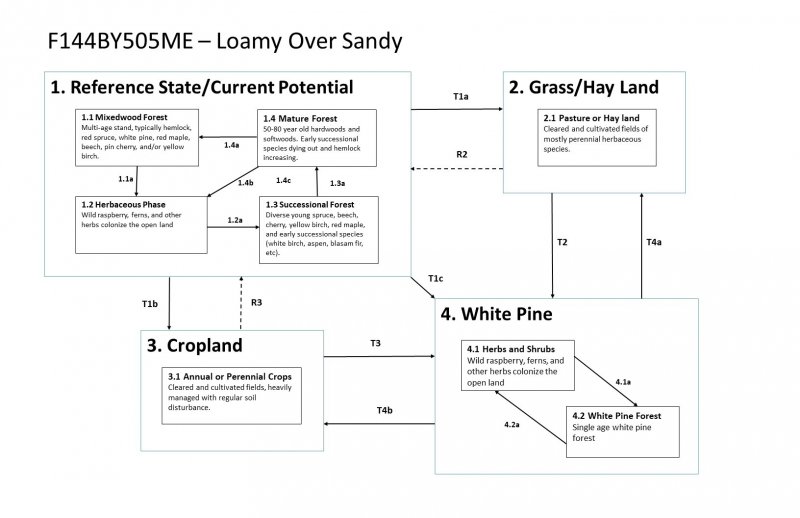
Natural Resources
Conservation Service
Ecological site F144BY505ME
Loamy over Sandy
Last updated: 9/27/2024
Accessed: 04/28/2025
General information
Provisional. A provisional ecological site description has undergone quality control and quality assurance review. It contains a working state and transition model and enough information to identify the ecological site.
MLRA notes
Major Land Resource Area (MLRA): 144B–New England and Eastern New York Upland, Northern Part
This major land resource area (MLRA) is in Maine (56 percent), New Hampshire (22 percent), Vermont (14 percent), Massachusetts (6 percent), Connecticut (1 percent), and New York (1 percent). It makes up about 22,728 square miles (58,864 square kilometers). The MLRA consists of a relatively young landscape shaped by the Laurentide Ice Sheet, which covered the region from 35,000 to 10,000 years ago. Rolling hills of dense basal till converge on ridges of shallow bedrock that were scoured by glacial ice. River valleys that were flooded by melting glacial water or seawater house large expanses of glacial outwash and stratified drift in inland areas and, to a lesser extent, glaciomarine and glaciolacustrine sediment deposits in coastal areas. Organic bogs, ablation till, and alluvial flood plains make up the remaining portions of the MLRA.
The soils in this region are dominantly Entisols, Spodosols, and Inceptisols. They commonly have a fragipan. The dominant suborders are Ochrepts, Orthods, Aquepts, Fluvents, and Saprists. The soils in the region dominantly have a frigid soil temperature regime with some cryic areas at higher elevation, a udic soil moisture regime, and mixed mineralogy. Most of the land is forested, and 98 percent is privately owned. Significant amounts of forest products are produced including lumber, pulpwood, Christmas trees, and maple syrup. Principal agricultural crops include forage and grains for dairy cattle, potatoes, apples, and blueberries. Wildlife habitat and recreation are important land uses. Stoniness, steep slopes, and poor drainage limit the use of many of the soils.
Classification relationships
NRCS:
Land Resource Region: R—Northeastern Forage and Forest Region
MLRA: 144B—New England and Eastern New York Upland, Northern Part
Ecological site concept
This site occurs on various landforms where soils are stratified, with finer textures underlain by sandy textures. This site concept requires further consideration, but seems to usually support conifer and/or hardwood species, notably hemlock, red maple, and beech.
This site includes the following state natural heritage program types:
• Hemlock-spruce-northern hardwoods forest (Sperduto and Nichols 2004)
• Spruce-Northern Hardwoods Forest (Gawler and Cutko 2010)
• Hemlock-spruce-northern hardwoods forest (Thompson and Sorenson 2000)
Similar sites
| F144BY502ME |
Loamy Till Toeslope The Loamy Till Toeslope site produces similar species, but is poorly- to somewhat poorly-drained with loamy textures and dense loamy subsoil, whereas the Loamy Over Sandy site is moderately well- to well-drained with sandy subsoil. |
|---|---|
| F144BY601ME |
Dry Sand The Dry Sand site does not have a loamy cap and is well- to excessively-drained, whereas the Loamy Over Sandy site is moderately well- to well-drained and supports more hardwood production. |
| F144BY602ME |
Sandy Toeslope The Sandy Flat site does not have a loamy cap and is somewhat poorly- to moderately well-drained, whereas the Loamy over Sandy site is moderately well- to well-drained. |
Table 1. Dominant plant species
| Tree |
(1) Tsuga canadensis |
|---|---|
| Shrub |
Not specified |
| Herbaceous |
Not specified |
Click on box and path labels to scroll to the respective text.
